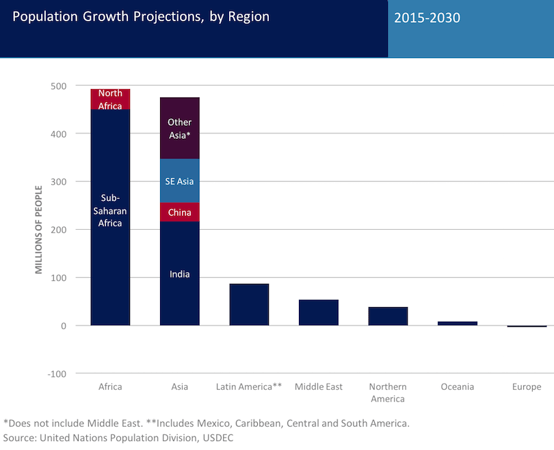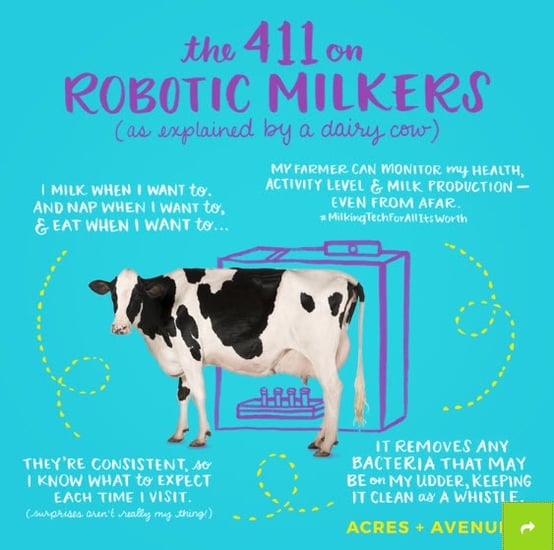-
Is This the Best Time Ever for Agriculture?
By USDEC October 25, 2017- Tweet
Agribusiness Academic Lowell Catlett sees three megatrends creating unprecedented opportunities for U.S. dairy exporters and others feeding the world.
Lowell Catlett has made a living observing megatrends in agriculture and says there is no better time than the present.

A former professor of agricultural economics and agricultural business at New Mexico State University, Catlett gives upbeat speeches filled with facts and figures to food and agriculture groups, including the U.S. Dairy Export Council. He addressed members at USDEC's Board of Directors and Membership Meeting in March and nothing has hindered his optimism since then.
Not only is this the best time to be in agriculture, he says, but the best time to be alive.
While some people look nostalgically on the past, the “good ole days” weren’t always that good, Catlett says. For many people, “life was really short and it was tough and it was brutal as hell.”
In 1900, the life expectancy for men in the United States was 46 years, on average. Today, it is 76.7 years. (And when the average for both men and women is figured, life expectancy in the United States is 79.1 years.)
Despite today's problems, there has been much progress. Catlett sees at least three megatrends that make him optimistic:

1. Millions climbing out of poverty
Look at the progress at reducing poverty around the world.
In 1981, according to The World Bank, 1.9 billion people or 42 percent of the world population were extremely poor. By 2013, that number had dropped to 767 million people or just below 11 percent of the world population when population growth is factored in, according to this recent article in The Economist.
The sharpest decline in poverty has occurred in China, points out this article in The Wall Street Journal.
Increasing affluence, combined with greater agricultural productivity, is making food more affordable for people around the world―not just in poor countries, but affluent countries as well.
Between 1960 and 2007, the share of disposable personal income spent on total food by Americans, on average, fell from 17.5 percent to 9.6 percent, says the USDA’s Economic Research Service.
“Agricultural sufficiency gave you back (nearly) 10 percent of your income because you didn’t have to spend it on food anymore,” Catlett says. “That’s a pretty powerful statement. By the way, we don’t eat one meal a week away from home. Folks, we eat one out of every two.”
And consumers have never had more choice when eating out, which creates new opportunities for dairy.
“If I’m eating one of every two meals away from home, I don’t want just American cheese anymore,” Catlett says, noting that besides traditional choices consumers can now choose from an array of artisan cheeses, organic cheeses and other market segments.
Fifty years ago, consumers didn't have those choices, Catlett says. “Now we have them in abundance.”
It’s yet another reason why this is the best time ever to be involved in agriculture, he adds.

2. Increasing capacity to produce food
After 30 years of rapid growth in agricultural production, the world can now produce enough food to provide every person with at least 2,700 calories per day. There is enough food for everyone in the world, if we can secure the access and distribution to make it happen. This document from the Food and Agriculture Organization of the United Nations backs up Catlett's point.
That wasn't always the case.
In 1970, there were 3.7 billion people on the planet―half of what there are today―and we could not provide for all of those people, Catlett says.
“Oh, we did quite nicely here and quite nicely in a few other countries,” he says, but in many countries people went hungry. Today, there are hunger pockets, but it has more to do with an inequity of distribution than whether the food capacity exists or not.
By 2050, the world population is expected to grow to 9.7 billion. The question, of course, is whether food production can keep up with population growth. Many countries, inclluding China, cannot make enough food for their own populations. They must import.
USDEC sees population growth and rising income in developing nations as key factors driving global dairy demand in the future. Read more.

3. Technology creating efficiencies
More and more farming decisions today are guided by technology.
Precision mapping, including physical sensors and GPS information, allows farmers to monitor their fields for crop moisture levels, soil nutrient levels, crop yield and more. This allows the farmer to accurately locate areas of need, such as low crop yield or low moisture levels, and react accordingly.
In the future “you will not plant a corn seed, you will not plant a soybean seed, you will not plant a wheat seed, you will not have an animal, you won’t have a tree that doesn’t have a sensor in it and they are going to be connected and somebody has a whole bunch of data to crunch,” Catlett says.
In the dairy industry, a prime example is the advent of robotic milking. While no one has exact numbers on how many farms have installed robotic milking equipment, everyone agrees that it has quickly gained momentum in the past several years. Read more.
Not only are robotics creating efficiencies for farmers, but cows seem to love them as well, Catlett says.

Robotics infographic reprinted from "Robotic Milkers From a Cow's Point of View" by DairyGood.
Robotics are also playing a bigger role at dairy processing plants.
Farmers have never had more information at their fingertips than they do now with seemingly infinite computer capacity. This is another reason why they have become so productive and able to keep up with a growing world population.
Just look at the new online resources available for the exporters of U.S. dairy products, shown here.
A final note on the financial picture
A final note: Agriculture is sitting on a net worth of $2.47 trillion and a very favorable debt-to-equity ratio of 15 percent, Catlett says. Across Fortune 500 companies, the average debt to equity ratio is 150 percent, he adds. “There isn’t a single industry on the planet that wouldn’t kill for the debt-to-equity ratio of agriculture.”
“I’m not making light of lower milk prices, lower corn prices,” Catlett says. “I’m just trying to tell you it is the platform that is the best ever in history.”
Mark O'Keefe is vice president of editorial services at the U.S. Dairy Export Council.
Subscribe to the U.S. Dairy Exporter Blog
The U.S. Dairy Export Council fosters collaborative industry partnerships with processors, trading companies and others to enhance global demand for U.S. dairy products and ingredients. USDEC is primarily supported by Dairy Management Inc. through the dairy farmer checkoff. How to republish this post. .
10 Most Recent Posts
Most Popular Posts in Past Year
Index of Posts by Topic
- #GotDairyJobs (4)
- About USDEC (65)
- Africa (6)
- Australia (4)
- Blog (8)
- Brazil (4)
- Canada (20)
- Central America (1)
- Cheese (58)
- Chile (1)
- China (54)
- Common food names (7)
- Company News (19)
- Consistent Supply (1)
- Crisis Management (3)
- Cuba (2)
- Dairy (6)
- Dairy checkoff (9)
- Dairy Ingredients (5)
- Dairy Management Inc. (2)
- Dairy Resources (1)
- Dairy Supply Chain (1)
- Dairy Trends (5)
- Documentation (3)
- EU (24)
- Experts on Dairy Exports (4)
- Exporter of the Year (2)
- Exports (24)
- Farmer leaders (1)
- Farming (38)
- Food Aid (8)
- Food Safety (8)
- Foodservice (3)
- Free trade agreements (34)
- Future trends (1)
- Geographical Indications (GIs) (10)
- Global Marketing (86)
- Global Shipping Crisis (1)
- Got Jobs? (9)
- Indonesia (1)
- Innovation (17)
- Japan (17)
- Krysta Harden (1)
- Market Access (25)
- Market Conditions (266)
- Member Services (17)
- Mexico (41)
- Middle East (9)
- Middle East & North Africa (3)
- Middle East/North Africa (9)
- Milk (4)
- Milk Protein Concentrate (MPC) (2)
- New Zealand (11)
- Next5% (20)
- Nonfat Dry Milk/Skim Milk Powder (8)
- Nutrition (19)
- Product Innovation (6)
- Protein (4)
- Regulations (5)
- Research & Data (324)
- Russia (3)
- Singapore (10)
- South America (8)
- South Korea (10)
- Southeast Asia (25)
- Strategic Insights (1)
- Supply (1)
- Sustainability (26)
- Technology (2)
- ThinkUSADairy (5)
- TPM23 (1)
- TPP (13)
- Traceability (8)
- Trade Barriers (5)
- Trade Data (7)
- Trade Policy (72)
- TTIP (5)
- UHT Milk (7)
- USMCA (2)
- Vietnam (4)
- Whey (6)
- Whey Ingredients (2)
- Whey products (10)
- Whole Milk Powder (WMP) (3)
- World Dairy Expo (1)
- World Milk Day (1)
- Yogurt (1)
Index of Posts by Date, Author
- June 2021 (13)
- March 2015 (12)
- September 2015 (12)
- April 2015 (11)
- December 2015 (11)
- March 2014 (10)
- February 2015 (10)
- October 2015 (10)
- October 2014 (9)
- June 2015 (9)
- July 2015 (9)
- November 2015 (9)
- March 2016 (9)
- October 2019 (9)
- September 2013 (8)
- May 2015 (8)
- August 2015 (8)
- January 2016 (8)
- February 2016 (8)
- March 2017 (8)
- December 2018 (8)
- May 2019 (8)
- December 2019 (8)
- June 2014 (7)
- November 2016 (7)
- May 2017 (7)
- May 2018 (7)
- July 2020 (7)
- June 2023 (7)
- July 2016 (6)
- August 2018 (6)
- October 2018 (6)
- November 2018 (6)
- February 2019 (6)
- June 2019 (6)
- August 2019 (6)
- March 2020 (6)
- April 2020 (6)
- June 2020 (6)
- June 2022 (6)
- February 2014 (5)
- June 2016 (5)
- August 2016 (5)
- September 2016 (5)
- December 2016 (5)
- February 2017 (5)
- July 2017 (5)
- October 2017 (5)
- January 2018 (5)
- April 2018 (5)
- June 2018 (5)
- July 2018 (5)
- September 2018 (5)
- January 2019 (5)
- March 2019 (5)
- April 2019 (5)
- July 2019 (5)
- September 2019 (5)
- November 2019 (5)
- January 2020 (5)
- August 2020 (5)
- October 2020 (5)
- April 2021 (5)
- January 2022 (5)
- May 2013 (4)
- September 2014 (4)
- April 2016 (4)
- May 2016 (4)
- October 2016 (4)
- January 2017 (4)
- April 2017 (4)
- June 2017 (4)
- August 2017 (4)
- September 2017 (4)
- December 2017 (4)
- February 2018 (4)
- February 2020 (4)
- May 2020 (4)
- February 2022 (4)
- September 2022 (4)
- April 2023 (4)
- December 2023 (4)
- November 2017 (3)
- March 2018 (3)
- September 2020 (3)
- December 2020 (3)
- February 2021 (3)
- May 2021 (3)
- August 2021 (3)
- December 2021 (3)
- March 2022 (3)
- April 2022 (3)
- May 2022 (3)
- October 2022 (3)
- December 2022 (3)
- May 2023 (3)
- July 2023 (3)
- November 2023 (3)
- March 2011 (2)
- June 2011 (2)
- September 2011 (2)
- March 2012 (2)
- June 2012 (2)
- July 2012 (2)
- March 2013 (2)
- July 2013 (2)
- November 2020 (2)
- January 2021 (2)
- March 2021 (2)
- July 2021 (2)
- September 2021 (2)
- October 2021 (2)
- November 2021 (2)
- July 2022 (2)
- August 2022 (2)
- January 2023 (2)
- March 2023 (2)
- October 2023 (2)
- January 2024 (2)
- February 2024 (2)
- April 2024 (2)
- June 2024 (2)
- July 2024 (2)
- November 2024 (2)
- December 2024 (2)
- February 2025 (2)
- June 2025 (2)
- July 2025 (2)
- September 2025 (2)
- January 2010 (1)
- February 2010 (1)
- March 2010 (1)
- April 2010 (1)
- May 2010 (1)
- June 2010 (1)
- July 2010 (1)
- August 2010 (1)
- September 2010 (1)
- October 2010 (1)
- November 2010 (1)
- December 2010 (1)
- January 2011 (1)
- February 2011 (1)
- April 2011 (1)
- May 2011 (1)
- July 2011 (1)
- August 2011 (1)
- October 2011 (1)
- November 2011 (1)
- December 2011 (1)
- January 2012 (1)
- February 2012 (1)
- April 2012 (1)
- August 2012 (1)
- September 2012 (1)
- October 2012 (1)
- November 2012 (1)
- December 2012 (1)
- January 2013 (1)
- February 2013 (1)
- April 2013 (1)
- June 2013 (1)
- August 2013 (1)
- October 2013 (1)
- November 2013 (1)
- December 2013 (1)
- January 2014 (1)
- April 2014 (1)
- May 2014 (1)
- November 2022 (1)
- February 2023 (1)
- August 2023 (1)
- September 2023 (1)
- March 2024 (1)
- May 2024 (1)
- August 2024 (1)
- September 2024 (1)
- October 2024 (1)
- January 2025 (1)
- March 2025 (1)
- April 2025 (1)
- May 2025 (1)
- August 2025 (1)
- USDEC (183)
- USDEC Staff (160)
- Alan Levitt (119)
- Tom Suber (41)
- Margaret Speich (22)
- Marc A.H. Beck (15)
- Vikki Nicholson-West (11)
- Angélique Hollister (11)
- Tom Vilsack (8)
- Jaime Castaneda (7)
- Matt McKnight (7)
- Véronique Lagrange (7)
- Margaret Speich and Mark O'Keefe (7)
- Ross Christieson (7)
- Paul Rogers (6)
- Shawna Morris (5)
- William Loux (5)
- Alan Levitt and Marc Beck (5)
- Krysta Harden (4)
- USDEC Communications (3)
- Kristi Saitama (3)
- Marilyn Hershey (3)
- Brad Gehrke (3)
- Tom Quaife (2)
- Nick Gardner (2)
- Jim Mulhern (2)
- Alan Levitt and William Loux (2)
- Kara McDonald (2)
- Luke Waring (2)
- Merle McNeil (2)
- Andrei Mikhalevsky (1)
- Rodrigo Fernandez (1)
- Dermot Carey (1)
- Jeremy Travis (1)
- Annie Bienvenue (1)
- Ross Christieson and Shawna Morris (1)
- Becky Nyman (1)
- Paul Rogers and Tom Quaife (1)
- Rick Ortman (1)
- Tony Rice (1)
- Barbara O’Brien (1)
- Paul Rogers and Mark O'Keefe (1)
- Dalilah Ghazalay (1)
- Amy Wagner (1)
- Mitchell Bowling (1)
- Erica Louder (1)
- Brad Scott (1)
- Amy Foor (1)
- Scott Lantz (1)
- Sandra Benson (1)
- Errico Auricchio (1)
- Jaclyn Krymowski (1)
- Krysta Harden, USDEC President and CEO (1)
.png)

